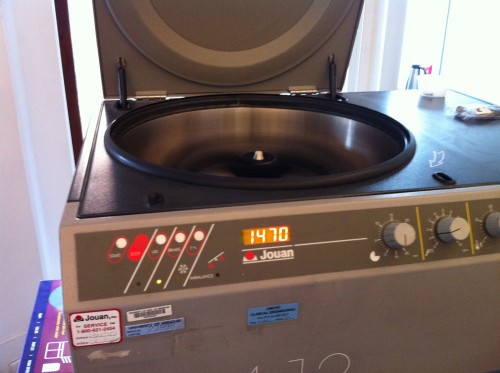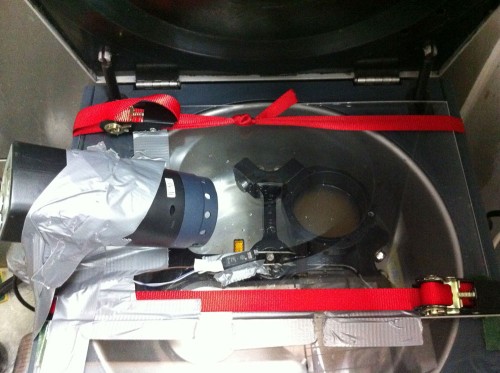by Dave Arnold

Centrifuges spin quickly, using centrifugal force to separate mixtures based on density: separating lighter oil from heavier nut solids, for instance, or separating clear delicious juice from heavier pulp. Don’t have a centrifuge yet? What are you waiting for? It is the must-have kitchen gadget from 6 years in the future. If you make a lot of juices in a bar or restaurant, it will pay for itself very quickly .
It is hard to know how fast or how long you really need to spin the centrifuge to get good separation. I figured the best way to know would be to watch it while it spun, so I shot a video using a hand-held strobe light tachometer I got cheap on eBay.

This video lets us examine the separation parameters — speed and time — of my most common centrifuge task: enzyme assisted centrifugal clarification (see here). The enzyme I use for clarification is Pectinex SP-L. It’s other magical properties include french fry augmentation, and citrus auto-supreming. The two liquids I test are orange juice and Gin Justino (banana blended with gin) Here it is:
The next centrifuge post will reveal my latest breakthrough in lime-juice clarification. I’ll tell you this: with the centrifuge and two magic ingredients you can source from any home-brew shop you can clarify fresh lime juice without heat in under an hour with greater than 95% yield and very little labor! Go buy one already.

I have an opportunity to buy a working refrigerated centrifuge for a low price. But it doesn’t have a rotor or buckets. I have looked on the web, but can’t find any sources. I’ve heard about your legendary ebay ninja skills. Has that encouraged you to find sources for centrifuge parts? Can you share?
Howdy Andrew,
The best way to get parts for one eBay centrifuge is to buy a second one that is broken in a different way. I’d be a bit leery of a centrifuge missing it’s rotor and buckets. A large fuge has rotors that are interchanged all the time –so a missing rotor makes sense. On the type that I use the rotor is semi-permanently attached with a lug nut. THey are only removed if something goes wrong. A missing rotor on a three liter bench-top (the only type I recommend) means something dire might have happened. Buckets and rotors cost a lot to buy new or reconditioned. The rotors are over a grand I think, and the buckets, if memory serves, are around 600. The best non-eBay place for parts (at least for the Jouans) is Ozark Biomedical.
What about using vacuum filtration to remove the solids? Are the particles too fine? It would be a lit cheaper and there are less potential safety issues.
B
Howdy Chemistry Boy,
Unfortunately, I have never had any luck with a Buchner Funnel and vacuum hooked up to an Erlenmeyer. The particles are too fine and the filter paper clogs right away because of the high volumes. I have done some multi-stage filtration, but clogging and speed have always been an issue. The centrifuge is, in the long run, not expensive (for someone making large volumes of product), because the yields are so high.
Awesome post.
Thanks.
Hah! Great job, Dave. I’ve been eyeing some of the refrigerated centrifuges lately, on auction sites. I suppose making the infamous pea butter is now the thing to try.
Two questions: Have you guys gotten anything really strange out of spinning it down? Also, do you think it’d be worth using one of these to concentrate yogurt? You could always re-add effluent, I assume, if you made it too hard. Quicker than cheesecloth, maybe.
Howdy J.R.
I’ve done yogurt. It works fine and is super quick. The olive oil post I did a while back might be the weirdest. I once blended a beer and a burrito and spun it down as a joke. That’s pretty weird. Weird good stuff happens when you find a use for the puck leftovers. Spun peach-puck mixed with sugar and LN frozen in the Kitchen aid has the texture of cold pumpkin-pie filling.
Okay,
Now I want a centrifuge… Actually I wanted one before… Ever since I had corn butter at Myrvold’s lab in Bellevue.
What size should I buy? Where to look? eBay? I think you mentioned once on the radio show about finding one super cheap because of a mis-spelled auction? Approximate cost?
Please answer on the radio show cause I listen to the podcasts religiously.
BTW- will you guys be at star chefs ICC?
Sorry Alvin, I forgot to paste this question into my radio list will do next week.
I’m a culinary student and i want you to know that your videos and your blog are very inspiring and i would love to see more =)
Awesome red jacket Dave Arnold!
Thanks bro. What’s shaking?
For those of you considering e-bay, don’t neglect the issue of chemical hygiene. If you pick up a used rotor, you may want to “bleach the rabies out of it”.
In addition, inspect used rotors carefully for cracks or excessive pitting and gouging. Your life may depend on it.
Howdy Kent,
Quite right people. Kent knows of what he speaks. Aside from being a founding member of the Experimental Cuisine Collective, he is a polymer chemist at NYU and the person who gave me my first training on a centrifuge.
I am continually amazed at the work you do on this blog, you are clearly a mad scientist.
Quick question, whats the purpose of this? Is it really that useful? If I understand right you are saying if you do this with fruit pulp, the benefit is that you get so much more juice out of the pulp?
Why did you use the banana gin here, was it just because it made for a nice demonstration, or did you want the clarified gin for something?
Seems like this’d be a crazy way to get massive amounts of Ghee real quick (except I suppose you’d want that heated, not cooled).
Howdy Schenck,
I make various versions of the banana drink –gin (but only Hendricks works well with bananas), bourbon (any), and rum (most) and serve them at events. It is usually served on the rocks with a twist of lemon or lime. It would take the solids out of ghee lickety split. It is also good to remove junk from infused oils, etc. There is no finer way to make juice (or more cost-effective).
Dave,
Am I correct to believe that in a newer model (Jouan CR 422) bench top centrifuge spinning at 4,000 RPMs, most of the damage *should* be contained within the unit in the event of catastrophic failure? Also, when spinning at these speeds, rotors don’t need to be de-rated, correct?
Lastly, are you guys still using plastic bags in the buckets? Centrifuge bottles appear to be crazy expensive. Any ideas for cheap alternatives?
Thanks again!
PS. I was the over-participator in the Sous Vide Intensive in September (sorry about that). I finally found a good deal on eBay for the fuge – $300 for the CR422, and I was able to pick it up in person!
Howdy Keith,
I have never heard of a modern bench-top centrifuge failing in a way that took out a whole room (the way ultra’s have), but I wouldn’t assume they are safe either. I haven’t de-rated my rotor but I am constantly checking the buckets for corrosion, etc. I usually spin directly in the buckets or in bags. I don’t see much point in spending the money on the bottles.
For anyone that is looking, Pectinex Ultra SP-L is available at http://www.modernistpantry.com/pectinex-ultra-spl.html